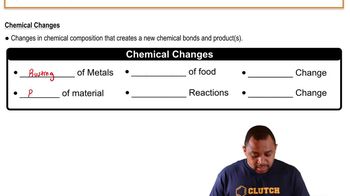The tabulated data were collected for this reaction at 500 °C: CH3CN(g) → CH3NC( g) b. What is the half-life for this reaction (at the initial concentration)?
Ch.15 - Chemical Kinetics
Chapter 15, Problem 91
Consider the reaction: A + B + C → D. The rate law for this reaction is: Rate = k [A][C]^2 [B]^1/2. Suppose the rate of the reaction at certain initial concentrations of A, B, and C is 0.0115 M/s. What is the rate of the reaction if the concentrations of A and C are doubled and the concentration of B is tripled?
 Verified step by step guidance
Verified step by step guidance1
Identify the given rate law: Rate = k [A][C]^2 [B]^{1/2}.
Note the initial rate of the reaction: 0.0115 M/s.
Determine the effect of doubling the concentration of A: The rate will be multiplied by 2, since the reaction is first order with respect to A.
Determine the effect of doubling the concentration of C: The rate will be multiplied by 2^2 = 4, since the reaction is second order with respect to C.
Determine the effect of tripling the concentration of B: The rate will be multiplied by (3)^{1/2}, since the reaction is half order with respect to B.
Key Concepts
Here are the essential concepts you must grasp in order to answer the question correctly.
Rate Law
The rate law of a chemical reaction expresses the relationship between the reaction rate and the concentrations of the reactants. It is typically formulated as Rate = k [A]^m [B]^n [C]^p, where k is the rate constant, and m, n, and p are the reaction orders with respect to each reactant. Understanding the rate law is essential for predicting how changes in concentration affect the reaction rate.
Recommended video:
Guided course

Rate Law Fundamentals
Reaction Order
Reaction order refers to the exponent of a reactant's concentration in the rate law, indicating how the rate of reaction is affected by that reactant. For example, in the rate law Rate = k [A][C]^2 [B]^1/2, the reaction is first order with respect to A, second order with respect to C, and half order with respect to B. This concept is crucial for calculating the new rate when concentrations change.
Recommended video:
Guided course

Average Bond Order
Concentration Changes
Changes in the concentrations of reactants directly influence the rate of a reaction according to the rate law. In this scenario, if the concentrations of A and C are doubled and B is tripled, the new rate can be calculated by substituting these new concentrations into the rate law. Understanding how to manipulate these concentrations is key to determining the new reaction rate.
Recommended video:
Guided course

Chemical Changes
Related Practice
Textbook Question
Textbook Question
The tabulated data were collected for this reaction at a certain temperature: X2Y → 2 X + Y a. Determine the order of the reaction and the value of the rate constant at this temperature.
Textbook Question
The tabulated data were collected for this reaction at a certain temperature: X2Y → 2 X + Y c. What is the concentration of X after 10.0 hours?
Textbook Question
Consider the reaction: 2 O3(g) → 3 O2( g) The rate law for this reaction is: Rate = k [O3]2 [O2] Suppose that a 1.0-L reaction vessel initially contains 1.0 mol of O3 and 1.0 mol of O2. What fraction of the O3 will have reacted when the rate falls to one-half of its initial value?
